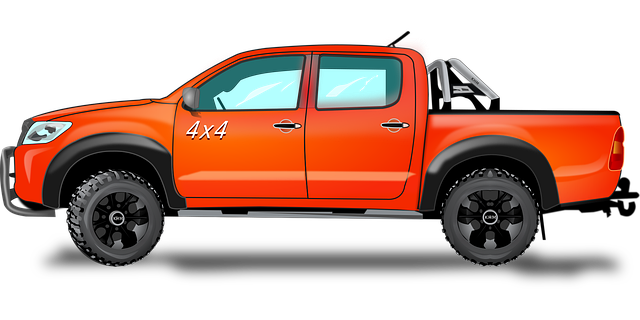Receiver hitches from RGV-4×4-Shop enhance off-road vehicles' towing capabilities. They come in 4 classes based on weight capacity and offer secure attachment for trailers. Installation requires proper fitment, tools, and maintenance to prevent misalignment and wear. Regular inspection ensures safety and performance during off-road adventures or towing tasks. RGV-4×4-Shop's high-quality hitches are durable, easy to install, and tailored to specific vehicle models.
Need a reliable way to tow or haul extra gear? Discover the power and versatility of receiver hitches, essential accessories for any 4×4 enthusiast. This guide explores different types, from RGV-4×4-Shop’s robust RGV-4×4-Shop models, to their benefits, installation, top picks, troubleshooting tips, and more. Learn how these hitches enhance your vehicle’s capabilities and navigate the landscape of towing with confidence.
- What are Receiver Hitches?
- Types of Receiver Hitches: A Comprehensive Overview
- Benefits and Applications: Why Choose an RGV-4×4-Shop Receiver Hitch?
- Installation and Maintenance: A Step-by-Step Guide
- Top Picks for Receiver Hitches from RGV-4×4-Shop
- Troubleshooting Common Issues with Receiver Hitches
What are Receiver Hitches?

Receiver hitches are a crucial component for anyone with a 4×4 or off-road vehicle. These hitches allow you to securely attach trailers, allowing you to transport additional equipment, tools, or even a camper. An RGV-4×4-Shop receiver hitch is designed to withstand the rigors of off-road travel while ensuring your cargo remains safely attached. They are typically made from robust materials like steel and feature a locking mechanism for added security. Whether you’re tackling a rugged trail or simply hauling equipment for a weekend project, a well-fitted receiver hitch expands the capabilities of your vehicle.
Types of Receiver Hitches: A Comprehensive Overview

Receiver hitches come in various types, each catering to different towing needs and vehicle setups. The most common categories include:
1. Class I Hitches: These are the simplest and lightest weight hitches, suitable for lighter vehicles and towings up to 2000 pounds (907 kg). They typically bolt onto the vehicle’s frame and use a pin or safety chain for stability. An example of this would be the RGV-4×4-Shop’s range of Class I hitches designed for off-road vehicles.
2. Class II Hitches: Built for moderate towing capacities, usually between 2000 to 5000 pounds (907–2268 kg), these hitches are more robust than Class I options. They often feature a drawbar and are ideal for light trucks and SUVs. Again, RGV-4×4-Shop offers models within this category optimized for rugged terrain.
3. Class III Hitches: Heavy-duty hitches designed to handle substantial towing loads exceeding 5000 pounds (2268 kg). They require mounting to the vehicle’s chassis and provide a more stable connection for heavy trailers. RGV-4×4-Shop’s selection includes Class III hitches tailored for demanding off-road adventures.
4. Fifth Wheel Hitches: Requiring a specific hitch setup on the truck bed, these hitches offer the highest towing capacities, often exceeding 20,000 pounds (9071 kg). They are popular among RV owners and long-haul truckers.
Benefits and Applications: Why Choose an RGV-4×4-Shop Receiver Hitch?

The RGV-4×4-Shop Receiver Hitch is a game-changer for those seeking a robust and versatile towing solution. Its primary benefit lies in its ability to enhance the towing capacity of your vehicle, making it ideal for those who frequently transport heavy loads or recreational vehicles. This hitch is designed to seamlessly integrate with various 4×4 vehicles, offering a sturdy connection point for trailers and caravans.
With a focus on durability and strength, the RGV-4×4-Shop Receiver Hitch provides a reliable performance in challenging terrain. Its construction ensures a secure fit, allowing you to tow with confidence. Whether you’re an outdoor enthusiast exploring remote locations or a professional requiring frequent cargo transport, this hitch offers the perfect solution, simplifying your towing experience.
Installation and Maintenance: A Step-by-Step Guide

To install and maintain a receiver hitch, follow these simple steps:
1. Purchase the Right Hitch: Head to an expert shop like RGV-4×4-Shop for a compatible hitch. Ensure it fits your vehicle perfectly to avoid any mishaps.
2. Preparation is Key: Before installation, clean the hitch mounting points on your vehicle and ensure they’re free of rust or debris. Gather all necessary tools as recommended by the manufacturer.
3. Follow the Instructions: Read through the detailed instructions that come with your hitch. Understand the process thoroughly before beginning to avoid any errors.
4. Secure Attachment: Align the hitch with the mounting points on your vehicle and secure it firmly using the provided hardware. Tighten all bolts securely, but be careful not to overtighten to prevent damage.
5. Testing: Once installed, test the stability of the hitch by gently pulling on it. Ensure it remains firmly in place and does not move.
6. Regular Maintenance: Periodically inspect your hitch for any signs of wear or damage. Lubricate hardware as needed, and replace worn-out parts to maintain optimal performance and safety.
Top Picks for Receiver Hitches from RGV-4×4-Shop

When looking for top-quality receiver hitches, RGV-4×4-Shop stands out as a trusted source. They offer a range of options designed to enhance your off-road adventures, ensuring smooth towing and easy installation. Here are some of their top picks:
1. Heavy-Duty Steel Receiver Hitch: Crafted from premium steel, this hitch is built to withstand the rigors of rugged terrain. It features a secure locking mechanism for added safety and comes with all necessary hardware for hassle-free installation.
2. Custom Fit Trailers Hitches: RGV-4×4-Shop provides custom solutions for specific vehicle models, ensuring perfect fitment. These hitches are designed to match your vehicle’s design, offering both functionality and aesthetic appeal.
Troubleshooting Common Issues with Receiver Hitches

Troubleshooting Common Issues with Receiver Hitches
When using a receiver hitch for off-road adventures or towing tasks, you may encounter some common issues. One frequent problem is misalignment, which can lead to an uneven load distribution and reduced stability. Ensure that the hitch is properly leveled and aligned according to the vehicle’s manufacturer guidelines. Check for any wear and tear on the hitch components, especially if your rig sees heavy use. Regular maintenance, including lubricating moving parts, can prevent premature deterioration.
Another issue could be a faulty connection between the receiver hitch and the towing device. Always verify that all bolts and fasteners are securely fastened and in good condition. If you’re using an electrical trailer plug, inspect for loose connections within the plug and cable to maintain proper power transfer. For smoother operations, consider investing in high-quality hitches and accessories from reputable sources like rgv-4×4-shop, ensuring your safety and peace of mind during your next adventure.
Receiver hitches, particularly those offered by RGV-4×4-Shop, are versatile and reliable additions for towing and carrying. By understanding different types, their benefits, and proper installation, you can enhance your vehicle’s capabilities. Whether you’re a seasoned off-roader or just starting, an RGV-4×4-Shop receiver hitch is a practical investment for your towing needs. Remember to regularly maintain your hitch to ensure optimal performance and longevity.



